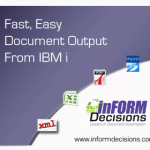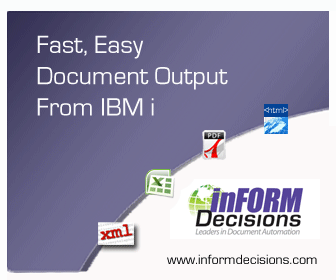TEMBO Sets Out to Save IBM i with Database Modernization
August 7, 2012
Marinus Van Sandwyk and his colleagues at TEMBO Technology Lab are determined to save the IBM i platform. It may sound farfetched on its surface. After all, isn’t that IBM’s job? But when you hear what Van Sandwyk has to say about the real limitations of the platform (i.e. its legacy ISAM database engine) and the potential solution (get thee to the SQL), you start to think he’s on to something.The user interface is widely blamed for being the biggest problem in the IBM i world. Few people want to work on a text-base, green-screen interface, and fewer still will pony up the hundreds of thousands of dollars to buy a new system of this type. Others insist that the system, as it stands, is great, but that it needs more marketing push from IBM.
While Van Sandwyk agrees that the UI is a concern on the surface, his work points to a bigger problem that lies much deeper: in the literal guts of the machine, and how programmers interface with those guts.
The real problem with the IBM i server, as Van Sandwyk sees it, is that the legacy ISAM database engine–the one providing the interface between DB2/400 and the mass majority of RPG and COBOL applications that are in use today–is insufficient to meet today’s demands. It’s insufficient because it doesn’t enforce triggers, referential constraints, and database validations. Instead, programmers must write these by hand, and place them in the business application itself, which leads to monolithic code bases filled with spaghetti code and maintenance nightmares.
The solution: use the SQL engine that IBM provides to access DB2/400. SQL allows the triggers and constraints and validations to be separated from the business logic, and to be placed in the database itself. This is a crucial component of the multi-tier-architecture approach that defines modern business application programming. It also allows for more agility, since programmers don’t have to worry about breaking the referential integrity of the application every time they change something. Also, SQL-based access is the way newer applications are developed in “modern” languages like Java, PHP, and .NET. Getting to SQL will make RPG and COBOL apps less strange, and more like coding for SQL Server, Oracle 11g, or other modern relational database management systems.
The solution sounds easy enough when it’s put in these terms. Just turn off the ISAM engine, turn on the SQL one, and you’re done, right? Alas, there are no easy solutions to this problem, which is literally decades in the making. To simplify the architecture and get out from under the maintenance burden, one must first untangle much of that spaghetti code. There’s no easy way around that. But once that work has been done, maintenance becomes much easier, performance improves, development skills become easier to obtain, and the IBM i server becomes more relevant in the future of organizations.
Business Development
TEMBO is building a business around helping IBM i shops to automate the process of moving from ISAM to SQL, and unraveling that code, for a cleaner, brighter tomorrow (to borrow a catchy political slogan). It launched its first product, called Adsero Optima (AO) Foundation earlier this year at the COMMON conference in Anaheim, California.
AO Foundation automates much of the work of moving from the ISAM to the SQL database engine, and does so in a way that eliminates the need to make Level ID changes. The avoidance of Level ID changes means that the software doesn’t need to be recompiled, which is a deal breaker in some instances. It also avoids the use of surrogates, which is the approach that IBM advocates to its IBM i shops as they build new Java, PHP, or .NET applications that will use the SQL engine to access the database. TEMBO’s approach is all about enabling SQL to work with the heritage RPG and COBOL apps–not the new stuff.
AO Foundation is currently in production at many sites in TEMBO’s homeland of South Africa, and the big product launch at COMMON in May caught the eye of at least one major U.S. company that’s considering adopting it, Van Sandwyk says. Much of TEMBO’s current work revolves around beating the drum for AO Foundation, including signing master distributors, doing marketing drives, and fine-tuning the product. It has already signed master distributors in North America and the Asia Pacific region, and is in final talks with a distributor for Europe, Van Sandwyk says.
The second product, called AO Logic, is currently in development. AO Logic’s job is to keep the SQL and ISAM databases in sync in a given IBM i shop. This is critical, because in TEMBO’s approach, the two technologies must live with each other, in practical perpetuity.
“AO Logic will be the product, by far, we are busy with the longest period,” Van Sandwyk says, “because it’s important to recognize that it’s never going to be a push-button exercise to move and encapsulate all the nuggets–all the pieces of logic that defines your competitive advantage–of your application. This is a gradual roadmap. We don’t say for a moment that people should modernize the entire system. What we say is they should focus on 20 percent of the business functions generating 80 percent of transactions. That is where the prime maintenance burden will be, and that’s what people will focus on.”
AO Logic will likely be released near the end of 2012, to be followed soon thereafter by the third and final leg of TEMBO’s approach, the multi-channel delivery product called AO Open. This product, due in the first quarter of 2013, will feature technology OEMed from TEMBO’s southern hemispherical business partner looksoftware and also maybe IBM’s Rational Open Access RPG Edition technology.
Van Sandwyk is also seeking the formal validation of his approach from IBM. After Anaheim, TEMBO executives made a pilgrimage to the IBM lab at Rochester, Minnesota, where the company’s product went before the judge, as it were, to see if it’s worthy. “In my estimate it went very well,” Van Sandwyk says. “They couldn’t find anything in the initial technology review where they say, ‘Guys you’re off your rocker.'”
To the contrary, Van Sandwyk and friends are firmly glued to their rockers. The renowned architect and technologist from South Africa is giving thoughtful answers and solutions to the question “What’s wrong with the IBM i server?”
“It comes back to the whole philosophy where we’re saying we believe there is truly huge value caught up in your heritage applications, what I like to refer to as nuggets or jewels,” Van Sandwyk says. “We want to find those and wrap them and basically extend the life of that competitive advantage going forward . . . for next 15 or 20 years, which we believe is realistic.”
See more at: http://www.itjungle.com/fhs/fhs080712-story01.html
More Information
To learn more about inFORM Decisions and the benefits of going paperless, visit www.informdecisions.com or phone 1.949.709.5838.
Note: Due to the strong legal and privacy constraints in the hospitality and gaming industries, inFORM Decisions cannot directly quote users, which is why there is no attribution for the quotes in this article. Because of this, we understand there might be some possible reader skepticism; however, we can provide individual customer references to prospects upon request.
About the Author:
inFORM Decisions (www.informdecisions.com) specializes in document management, payment automation and modernization solutions for IBM i (iSeries). inFORM’s acclaimed iDocs Suite make it easy to design, add intelligence, archive and/or intelligently distribute electronic documents, reports and checks to laser printers, fax, or email (in popular formats like PDF, Excel, RTF, HTML, TEXT and more). The company distributes the database modernization solution, Adsero Optima Foundation, to facilitate and automate the migration of all legacy (ISAM or DDS) databases to the latest DDL (SQL/SQE) implementation of DB2 on IBM i. To learn more, visit www.informdecisions.com or call 949.709.5838

